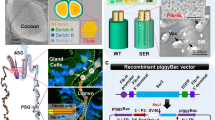Abstract
Research on spider silk proteins has led to the possibility of designing genetically engineered silks according to defined material properties. Here we show the efficient and stable production of spider silk-elastin fusion proteins in transgenic tobacco and potato plants by retention in the ER. The proteins were purified by a simple method, using heat treatment and ‘inverse transition cycling’. Laboratory scale extraction of 1 kg tobacco leaf material leads to a yield of 80 mg pure recombinant spider silk-elastin protein. As a possible application, as well as to demonstrate biocompatibility, the growth of anchorage-dependent mammalian cells on spider silk-elastin coated culture plates was compared with conventional coatings such as collagen, fibronectin and poly-D-lysine. The anchorage-dependent chondrocytes showed similar growth behaviour and a rounded phenotype on collagen and on spider silk-elastin coated plates and the proliferation was remarkably superior to untreated polystyrene plates.
Similar content being viewed by others
References
Artsaenko O, Kettig B, Fiedler U, Conrad U and Düring K (1998) Potato tubers as a biofactory for recombinant antibodies. Mol Breeding 4: 313–319.
Betre H, Setton L A, Meyer DE and Chilkoti A (2002) Characterization of a genetically engineered elastin-like polypeptide for cartilaginous tissue repair. Biomacromolecules 3: 910–916.
Bevan M (1984) Binary Agrobacterium vectors for plant transformation.Nucl Acids Res 12: 8711–8721.
Conrad U, Fiedler U, Artsaenko O and Phillips J (1997) Singlechain Fv antibodies expressed in plants. In: Cunningham C and Porter S (eds.), Methods in Biotechnology-Recombinant Proteins from Plants: Production and Isolation of Clinically Useful Compounds. (pp. 103–127) Humana Press, Totowa.
Daniell H, Streatfield SJ and Wycoff K (2001) Medical molecular farming: production of antibodies, biopharmaceuticals and edible vaccines in plants. Trends Plant Sci 6: 219–226.
Dunham BP and Koch RJ (1998) Basic fibroblast growth factor and insulinlike growth factor I support the growth of human septal chondrocytes in a serum-free environment. Arch Otolaryngol Head Neck Surg 124: 1325–1330.
Gosline JM, Guerette PA, Ortlepp CS and Savage KN (1999) The mechanical design of spider silks: from fibroin sequence to mechanical function J Exp Biol 202: 3295–3303.
Hayashi CY and Lewis RV (2000) Molecular architecture and evolution of a modular spider silk protein gene. Science 287: 1477–1479.
Hinman MB and Lewis RV (1992) Isolation of a clone encoding a second dragline silk fibroin. Nephila clavipes dragline silk is a two-protein fiber. J Biol Chem 267: 19320–19324.
Hinman MB, Jones AJ and Lewis RV (2000) Synthetic spider silk: a modular fiber Trends Biotechnol 18: 374–379.
Larrick JW and Thomas DW (2001) Producing proteins in transgenic plants and animals. Current Opinion Biotech 12: 411–418.
McPherson JM, Yaeger PC, Brown ME, Hanlon JG and Binette F (2000) Chondrocyte media formulations and culture procedures.United States Patent 6,150,163.
Meyer DE and Chilkoti A (1999) Purification of recombinant proteins by fusion with thermally-responsive polypeptides. Nat Biotech 17: 1112–1115.
Munro S and Pelham HR (1987) A C-terminal signal prevents secretion of luminal ER proteins. Cell 48: 899–907.
Richter LJ, Thanavala Y, Arntzen CJ and Mason HS (2001) Production of hepatitis B surface antigen in transgenic plants for oral immunization. Nat Biotech 18: 1167–1171.
Rosenbloom J, Abrams WR and Mecham R (1993) Extracellular matrix 4: the elastic fiber. Faseb J 7: 1208–1218.
Scheller J, Gührs KH, Grosse F and Conrad U (2001) Production of spider silk proteins in tobacco and potato. Nat Biotech 19: 573–577.
Tirrell DA (1996) Putting a new spin on spider silk. Science 271: 39–40.
Urry DW (1988) Entropic elastic processes in protein mechanisms II. Simple (passive) and coupled (active) development of elastic forces. J Protein Chem 7: 1–34.
Vollrath F (2000) Strength and structure of spiders' silks. J Biotechnol 74: 67–83.
Vollrath F and Knight DP (2001) Liquid crystalline spinning of spider silk. Nature 410: 541–548.
Xiang C, Han P, Lutziger I, Wang K and Oliver DJ (1999) A mini binary vector series for plant transformation. Plant Mol Biol 40: 711–717.
Zambrinski P, Joos H, Gentello J, Leemans J, Van Montagu M and Schell J (1983) Ti-plasmid vector for introduction of DNA into plant cells without altering their normal regeneration capacity. EMBO J 2: 2143–2121.
Author information
Authors and Affiliations
Corresponding author
Rights and permissions
About this article
Cite this article
Scheller, J., Henggeler, D., Viviani, A. et al. Purification of Spider Silk-elastin from Transgenic Plants and Application for Human Chondrocyte Proliferation. Transgenic Res 13, 51–57 (2004). https://doi.org/10.1023/B:TRAG.0000017175.78809.7a
Issue Date:
DOI: https://doi.org/10.1023/B:TRAG.0000017175.78809.7a




